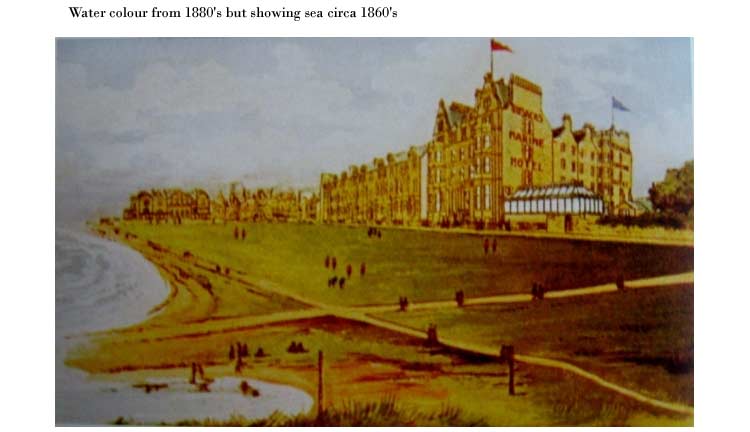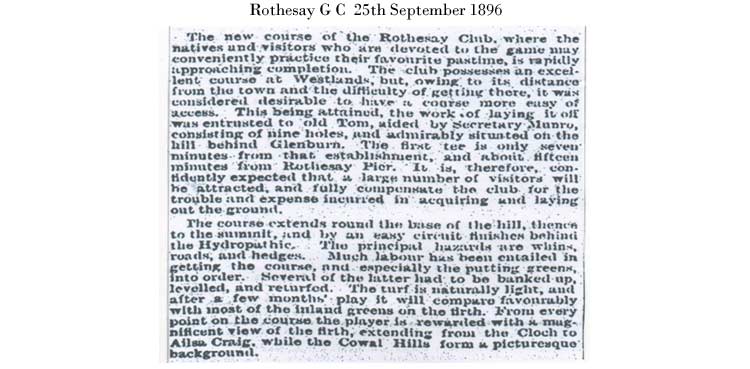Why don’t more modern architects incorporate such features as width into their designs?
Now, that is a good question. I just do not know why. I can guess that their clients are not interested, and what Designer is going to try to refocus the mind of a potential Client due to fear of losing the commission – a brave one indeed. So I have some sympathy for our humble (said, tongue in cheek) Designers in these hard times. However, one has to ask why did they not mention it when times were so much better? Now that comes down to the individual choice, I suppose, or perhaps some might look at it as a confidence in one’s own abilities.
Perhaps we need to look at modern design to find what exactly we mean; what defines a golf course design? Is it the choice of land; the degree of remodeling required to the land; the routing or, as I believe, it encompasses the whole lot. A blank canvas for a GCA must be the worst possible scenario. Having to kill the land to develop a course is to give that course a bastard start. In GCA, IMHO, there is nothing easier than a blank canvas governed only by the limitations of the client’s budget. I wonder how many architects jump to consider using a template to fill their void, and how many will be seeking that most dull of all Holes, the Island Green? In fact, what is there to motivate the designer and help him understand the environment to the point of producing a sustainable challenging course? – Perhaps some degree of luck in getting the right client. Now what is generally produced? Yes you got it, a clone of recent past courses known more for their super green manicured Greens and Fairways, crisscrossed by cart paths and carts, with zombie players only showing signs of life when using their electronic distance aids. The ‘tell’ is the expression on their face with the shock of not knowing what 160 yards actually looks like, thus still confused as to which club to select.
Designers, I believe, have a duty to thrill, to wake up the mindless bored player and make him/her want to play; in fact, to walk and think the game as he/she goes around the course.
The simple inclusion of wide fairways straight away allows the designer the opportunity to offer alternative approaches to the greens. However, much of this has been negated thanks to the technical specification of equipment and the distance the ball can fly because of that reason.
Today we have that little problem, who actually designed the course? Who was responsible for this great course? Just who has pushed me to delve deep within myself, nay force me to dig deep; to find my levels of skill, to make or break my golfing day? Who is this magician, this purveyor of pain and pleasure? Alas, we may never know their name if employed by a big company under the name of some past great golfer whose only contact with the course may be putting his name to that company.
Come on we need to know; we want to know. Do the heads of these companies not want us to know the individual’s name? Are they just happy to bask under the comment, ‘it’s a team effort’ but still claim it as being from the company of this or that great name?
Stop blurring the issues. Let’s start with knowing who was responsible, give credit where credit is due. Allow a little cult worship, to building up his/her fan base to see if their next effort matches the last; or was it just a lucky break thanks to the land or whatever.
As I have said many times and certainly on GCA.com, we can learn much from the past. We can incorporate many of the old ideas but we do need to be more selective and let clients know about potential sustainability of the land they have chosen with the anticipated on-going maintenance burden of that site.
This strip back the land to base rock then re terraforming it or re moulding it to represent that which it is not (and never will be), is pure madness. Do we need the depth of drainage modern courses require to be incorporated within their build? Is there the need for massive irrigation works? Both can be accommodated by good land selection, but of course that might not be in the location or suitable, and then we need to learn to work with Nature not keep forcing the issues expecting the old golfers to always pay the final bill.
There must be a duty of care by both the Client/Club and Designer aimed at the golfer to give him a cost effective, sustainable course with minimal, on-going, maintenance costs. And to reiterate, perhaps, more informative lessons than just how to grip and hit a ball, perhaps a little info on GCA to best take advantage of their new course.
Also, while we do have some course that can be reversed would it not add more spice to the club game if their courses could be easily reversed. Two for the price of one and just think of the added attraction of playing the normal course in reverse. Although I feel that should only be undertaken at limited times during the year to maintain interest and the novelty of reversing play.
The bunkers on the Old Course were much more varied in appearance in Old Tom Morris’s day. As such they meted out a different penalty depending on where your ball landed in them, that bunker’s bank, etc. Now all the bunkers are revetted with the primary benefit being that the course is ready for play in an instance regardless of extreme weather. Are you a fan of how the bunkers have been handled over time on The Old Course?
The debate regard, narrow or wide fairways are based upon TOC which until the mid-1860 was regarded as narrow. This being caused, in part, by the sea incursion right over what we call The Bruce Embankment, which today represents the 1st Hole on The Old Course. (The Google photo below shows the blue line representing the approximate high tide mark around the 1850’s before the two phase of reclaiming land back from the sea). This was started by Playfair and continued by Old Tom and Bruce. Please note, that some artistic licence has been incorporated into the water colour picture as by the time the water was this high The R&A Club House had just been built as a single story building and there was no Rusack Hotel, yet it is clearly depicted in the picture. However, it gives a generalisation of the sea incursion at high tide.
While land was being reclaimed at the 1st Hole, a constant battle was waged for decades by Old Tom at the other end of the course facing the Eden. After a severe storm Old Tom would rush out to see if the 7/11th Greens where still there.
The Current site of The Car Park & British Golf Museum has been reclaimed from the sea by aid of the barges filled with stones as seen in the photo below.
We must at the same time, not forget the massive amount of whins & brush which forced the game to be played upon relative narrow fairways until Old Tom started much of its removal.
Therefore, with the land reclaimed from the sea and the whins/brush removed, the course was significantly widened, however this left the course devoid of the hazard or permanent traps that the whins once created, therefore additional bunkers were required. The result being that TOC was completely re-designed including encasing the Swilkern Burn with new Greens, as mentioned earlier, resulting in TOC actually became a fully designed course for the first time in its long existence.
Old Tom preferred to make the bunkers as natural as possible. However, certain bunkers received more wear and tear thanks to the golfers climbing out the front, so to maintain the integrity of the face of the bunker he produced sod or as some today call it, revetted faced bunkers. This is not a new idea created in the 20th Century but was used by Old Tom and others in the last quarter of the 19th Century. To prove the point the following photo comes from the book ‘British Golf Links’ from 1897
The sod bunker is nothing new and was well known in Scotland in the 19th Century, and my understanding is that the idea started in Fife.
Old Tom used bunkers be they formed from the natural or made, but well filled with sand. Yet to my knowledge he never utilised firm shallow bunkers, as in his day bunkers were never raked allowing for the possibility of an additional hazard, a difficult lie. A great way of playing golf, however, it does not sit well with the idea of a super manicured course where there is a place for everything and everything in its place (perhaps including some fake half rotten sleepers to give age to a new course i.e. Castle Stuart).
One unusual aspect utilised by some of the early designers was the late placement of bunkers on a golf course. Some would wait as much as 3 months before returning to place and build the bunkers. This allowed the designers to understand the general direction of play, be it as intended or not.
The placement forced the golfers to re think their strategy being their favourite path was blocked by an additional hazard or two. Having said that, the placement of the bunkers to the front guarding the Green was generally Old Tom’s intention (a pair if possible) pushing the golfer to commit to the challenge or keep it safe. These were small deep bunkers known as Pot Bunkers and are a true test for any competent golfer.
I understand the need and in many places bunkers can have the sod walls, although I am still very much at home with a natural looking bunker left to the elements. However we must, in these days consider wear & tear, so sods are a good idea except when ones ball comes to rest in a crevice between the sods, then it is a terrible idea. No, I jest, with the collapse of manners and course etiquette in today’s game there is a need for the sods as many people just do not seem to care about the course, walking out over the front of any bunker thereby helping erode the face.
I do firmly believe that shallow and firm bunkers are pointless and just offer up a helping hand to a golfer and his wayward shot. For me it is one of the sins many a modern designer has included within their plans, more, I feel they assist today’s players rather than test them and their skills. One other point re bunkers (again seems a modern detail) is placement of bunkers all around the Green, as with Island Greens but surrounded in sand, again many appear to be firm and shallow, pointless IMHO.
Finally on bunkers, I wish the rear of the Green was not guarded allowing any ball that overshoots the Green to continue its journey. This IMHO is far more effective than having an island Green as it does allow a possibility of a recovery, keeping the player in the game, yet penalising him/her (yet not killing his/her game) as a result of a poor shot.
What are your three favorite courses built after 1960?
I think my favourite must be Askernish then Castle Stuart and Renaissance although I will throw in Kingsbarn as what I call an international course formed to represent a traditional Scottish Course.
Askernish just for its simplicity, brilliance and what can be done by a dedicated team if the land it truly fit for purpose. It is real Golf, 19th Century Golf as it was when golf was exported all over the world. It’s a true Links Course offering up all the conditions, sometimes with a vengeance, that one expects from a Links Course. You know you have combated Nature at Askernish and all the modern aids are of little help being made more or less redundant by the effect of the environment.
Castle Stuart, once you get passed the abundance of sleepers and a few fake trimmings, offers some spectacular views, yet it too seems to reflect that international taste of what is presumed as a pure Scottish course which it appears to want to promote. Having said that, Holes near the water appear to be well thought out and the Greens look most welcoming. Again the location has played a part yet it appears to have been sympathetically blended within the plan of the course, something I can never say about The Castle, St. Andrews.
Renaissance, now this was an interesting one for me. I love Muirfield with all its little warts, so would I like what I had thought would be a classic International course? Well, yes. From what I have seen, and a chat with others, it has surprised me, to the point that yes, I do like it.
But then over the years of reading Tom Doak’s post on GCA, I have discovered that we are rather close when it comes down to GCA, well, so it seems from my perspective. This may now ruin Mr Doak’s reputation, but then just go to the Renaissance Club and you will immediately regain total respect for the man and his design. It is certainly worth a visit, although perhaps defined by some as a links course it may seems strange when you encounter the trees. Yes, I like the Renaissance course but it’s a pity that the doors do not seem to want to open for competent golfers. But then I also love Luffness New and understand their view regards their Members wanting to relax within their club house and upon their course.
I still get drawn back to TOC, while the above courses are new they have not had the foot traffic of 6 Centuries that has helped compact the land. For 5 of those 6 centuries the course matured by allowing free ranging of the sheep and cattle and the humble, earth worm. Old Tom stopped the cattle grazing but allowed the sheep to continue cropping the grass while their droppings improved the turf. In many an old report on other new courses, we read that the course needs to have some play to help improve its quality, well, TOC has certainly had that with the result being that the turf is so enjoyable to play upon. The worms have gone but still modern machinery has taken their place giving us a fast and firm links course that is a joy to walk, let alone play upon. Courses like cars need to be run in, soil needs to settle, grass and turf need to mature, binding together for that fast and firmness being the ultimate goal. In time Askernish, Castle Stuart and Renaissance will fare as TOC and we will then be able to really judge their true qualities. Alas, it will be at least another century or two before that will happen.
Any concluding thoughts?
I attach a few newspaper clippings for general information relating to Old Tom, showing the amount of work he undertook as an old man in his 70’s. For those interested, I include two projects he was due to undertake but thanks to his work commitments he had to decline – one being Braid Hills in 1889 as he was in Northern Ireland, and the second was Kingussie in 1895 when he was involved with The Bridge of Allan course. The Bridge of Allan course is reputed to be another course that has changed little since Old Tom’s days.
A Caddie was original there to carry a Gentleman’s clubs – not in a bag but loose. Their silence was expected but today Caddies are regarded as Tourist/Golf Information Centres. If you use a Caddie, seek his silence mode to enable you to fully interact with the virgin course you are about to play. After all, they say you always remember your first time – it will mean so much more if you play it unaided. Utilise the Caddies experience (if you must) on your second round.
The Ball has now dropped into the 18th Cup
The End – unless anyone wants a drink?

















